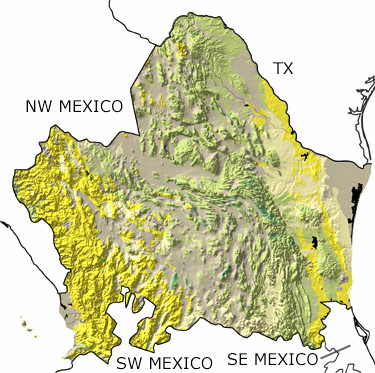Northeast region, Mexico
|
|
|||||||||||||||||||||||||||||||||||||||||||||||||||||||||||||
Paleontology and geology
The Precambrian: Precambrian rocks in the Northeastern Region of Mexico formed as volcanic islands, oceanic sediments, and part of the continent of Gondwana, an ocean away from Laurentia (ancient North America). These igneous, sedimentary, and metamorphic rocks date back to 1.0 Ga. They reached their present location by the movement of tectonic plates.
The Paleozoic: Paleozoic rocks in the Northeastern Region of Mexico were deposited in shallow to deep seas off the coast of Gondwana. These seas were home to many different invertebrates, some of which built up reefs. Over time, Gondwana moved closer to Laurentia, and by the end of the Paleozoic, the two continents collided to form the supercontinent Pangea. This collision folded and faulted rocks, pushing up some areas and dropping others into basins. It also brought rocks from the margin of Gondwana to their present location in the eastern part of this region. To the west, shallow to deep seas swept out to the open ocean, where there were many volcanic islands.
The Mesozoic: Pangea broke apart in the Mesozoic, and the Gulf of Mexico opened up in the east. In the west, subduction added volcanic islands and slices of oceanic crust to the continent. This activity brought magma near the surface, forming volcanoes and huge blocks of granite below older rocks. Forests, swamps, and lakes covered the land, where many different dinosaurs, other reptiles, and early mammals lived. By the end of the era, shallow seas flooded the eastern part of this region, and the western part was pushed up. The shallow to deep seas were filled with invertebrates, bony fish, sharks, and marine reptiles.
The Cenozoic: In the Cenozoic, interactions between the oceanic and continental plates in the west pushed up much of the region and generated significant volcanism. Basins and mountain ranges formed in the north, volcanoes erupted lava and ash over the surface, and many rocks were folded and faulted. The seas on both coasts were filled with many vertebrates and invertebrates. On land, forests, grasslands, and lakes hosted a wide range of mammals from North and South America, as well as invertebrates, reptiles, amphibians, fish, and birds.
Links to more on Northeast region paleontology
Careers | Organizations | Research and Collections | Resources
CareersOrganizationsDegree and Certificate Programs (showing 1 of 1 listings)
Universidad Autonoma de Nuevo León, School of Earth Sciences: Located in Monterrey, Nuevo León, UANL, the third largest Mexican university, offers a doctoral program in Geosciences with an emphasis in paleontology at its Linares campus.
Research and CollectionsSocieties and Clubs (showing 1 of 1 listings)
Sociedad Mexicana de Paleontologia A.C.: Information on the organization's history, membership, publications, etc.
Museums (showing 3 of 3 listings)
Museo Paleontológico de la Laguna: Tthis small museum contains invertebrate, vertebrate, and plant fossils collected primarily from the state of Coahuila. Some are also from Chihuahua and Durango. Also see http://www.torreon.gob.mx/laciudad/turismo/museos/paleontologia.php for 360-degree virtual tours of each room.
Museo de Historia Natural "Jose Vilet Brullet": Exhibits include ammonites, fossil fish, insects in amber, and more.
Museo del Desierto, Forecastle, Coahuila: This museum has a T. rex, Quetzalcoatalus, and more on display. It also conducts research in association with paleontologists in Germany, Utah, and Alberta, Canada.
ResourcesOngoing Research Projects (showing 2 of 2 listings)
Un Pterosauro Tamaulipeco: A report on fossil vertebrates recovered from an Early Jurassic site in Tamaulipas since 1985.
Wade E. Miller PaleoProfile: Miller is Professor of Geology and Paleontology at BYU, and does field research in central Mexico.
History of Paleontology (showing 2 of 2 listings)
The Importance of Fossils: A short history of paleontology in Mexico written in May 2000.
Dinosaurios en México: A history of dinosaur discoveries in Mexico.
General Reference (showing 3 of 5 listings)
Dinosaurios Mexicanos: A 1998 description of Mexican dinosaur discoveries, with a focus on Coahuila.
Equinodermos fósiles de México: An examination of the known fossil echinoderms from Mexico.
Cretaceous paleoflora of Coahuila, Mexico: A discussion of fossil plants from the Elm Formation accompanied by photographs.

